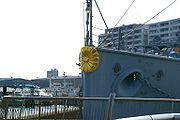
Imperial Seal of Japan
Encyclopedia


Imperial Seal
Imperial Seal refers to the seal used by imperial families to endorse imperial edicts.* Imperial Seal of China* Imperial Seal of Japan* Imperial Seal of Mongolia...
of Japan
Japan
Japan is an island nation in East Asia. Located in the Pacific Ocean, it lies to the east of the Sea of Japan, China, North Korea, South Korea and Russia, stretching from the Sea of Okhotsk in the north to the East China Sea and Taiwan in the south...
is a mon or crest used by members of the Japanese Imperial family. Under the Meiji Constitution
Meiji Constitution
The ', known informally as the ', was the organic law of the Japanese empire, in force from November 29, 1890 until May 2, 1947.-Outline:...
, no one was permitted to use the Imperial Seal except the Emperor of Japan
Emperor of Japan
The Emperor of Japan is, according to the 1947 Constitution of Japan, "the symbol of the state and of the unity of the people." He is a ceremonial figurehead under a form of constitutional monarchy and is head of the Japanese Imperial Family with functions as head of state. He is also the highest...
, who used a 16 petal chrysanthemum with sixteen tips of another row of petals showing behind the first row. Therefore, each member of the Imperial family used a slightly modified version of the seal. Shinto
Shinto
or Shintoism, also kami-no-michi, is the indigenous spirituality of Japan and the Japanese people. It is a set of practices, to be carried out diligently, to establish a connection between present day Japan and its ancient past. Shinto practices were first recorded and codified in the written...
shrines either displayed the imperial seal or incorporated elements of the seal into their own emblems.
Earlier in Japanese history, when Emperor Go-Daigo
Emperor Go-Daigo
Emperor Go-Daigo was the 96th emperor of Japan, according to the traditional order of succession....
, who tried to break the power of the shogunate 1333, was exiled, he adopted the seventeen petal chrysanthemum to differentiate himself from his successor, Emperor Kōgon, who kept the imperial 16 petal mon.
The symbol is a yellow or orange chrysanthemum
Chrysanthemum
Chrysanthemums, often called mums or chrysanths, are of the genus constituting approximately 30 species of perennial flowering plants in the family Asteraceae which is native to Asia and northeastern Europe.-Etymology:...
with black or red outlines and background. A central disc is surrounded by a front set of 16 petals. A rear set of 16 petals are half staggered in relation to the front set and are visible at the edges of the flower. An example of the chrysanthemum being used is in the badge for the Order of the Chrysanthemum
Order of the Chrysanthemum
is Japan's highest order. The Grand Cordon of the Order was established in 1876 by Emperor Meiji of Japan; the collar of the Order was added on January 4, 1888. Although technically the order has only one class, it can either be awarded with collar , or with grand cordon...
.
Other members of the Imperial Family
Imperial House of Japan
The , also referred to as the Imperial Family or the Yamato Dynasty, comprises those members of the extended family of the reigning Emperor of Japan who undertake official and public duties. Under the present Constitution of Japan, the emperor is the symbol of the state and unity of the people...
use a version with 14 single petals, while a form with 16 single petals is used for Diet
Diet of Japan
The is Japan's bicameral legislature. It is composed of a lower house, called the House of Representatives, and an upper house, called the House of Councillors. Both houses of the Diet are directly elected under a parallel voting system. In addition to passing laws, the Diet is formally...
members' pins, orders, passports, etc. The Imperial Seal is also used on the standards of the imperial family.
See also
- Chrysanthemum ThroneChrysanthemum ThroneThe is the English term used to identify the throne of the Emperor of Japan. The term can refer to very specific seating, such as the takamikura throne in the Shishin-den at Kyoto Imperial Palace....
- State Seal of JapanState Seal of JapanThe Great Seal of Japan is the Japanese official seal of state. It is cubic. The characters 大日本國璽 are carved in the archaic Chinese Seal script...
- Privy Seal of JapanPrivy Seal of JapanThe Privy Seal of Japan is the Emperor of Japan's official seal. It is square and its inscription "天皇御璽" is written in the seal script . It has two lines of vertical writing. On the right-hand side is "天皇" and on left-hand side is "御璽"...
- Order of the ChrysanthemumOrder of the Chrysanthemumis Japan's highest order. The Grand Cordon of the Order was established in 1876 by Emperor Meiji of Japan; the collar of the Order was added on January 4, 1888. Although technically the order has only one class, it can either be awarded with collar , or with grand cordon...
- List of Japanese flags
- Government Seal of JapanGovernment Seal of JapanThe Government Seal of Japan, also called the ' is a mon or a crest used by the Cabinet of Japan and the Government of Japan on official documents. One version is used as the official emblem of the office of the Prime Minister of Japan...
- Kimi ga YoKimi ga Yois the national anthem of post-1868 Japan. It is also one of the world's shortest national anthems in current use, with a length of 11 measures and 32 characters. Its lyrics are based on a Waka poem written in the Heian period , sung to a melody written in the imperial period...
- Flag of JapanFlag of JapanThe national flag of Japan is a white rectangular flag with a large red disk in the center. This flag is officially called in Japanese, but is more commonly known as ....

